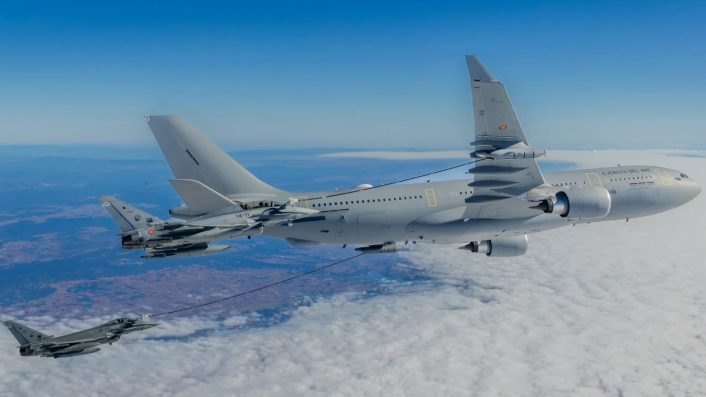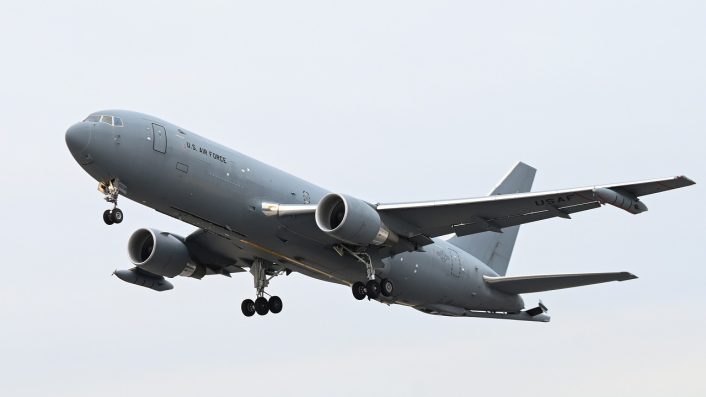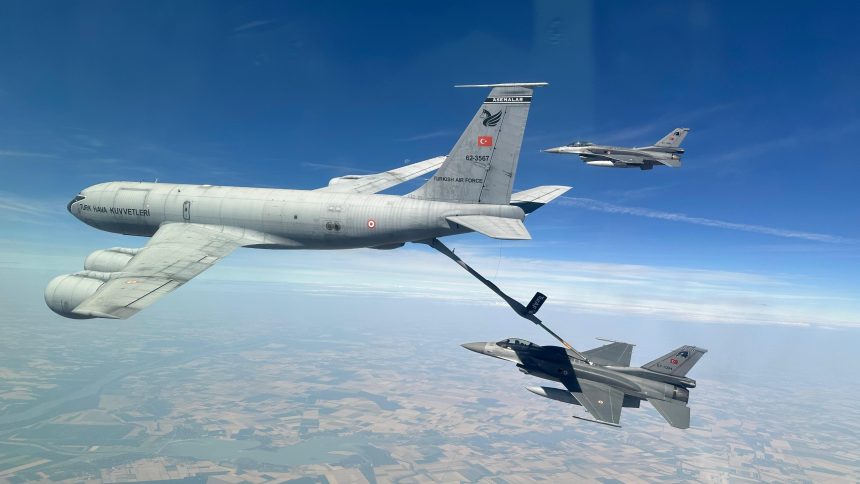Turkey is evaluating a replacement for its aging KC-135R Stratotanker fleet, with the KC-46 Pegasus and the A330 MRTT being the two candidates.
Turkey has narrowed the candidates for the Türk Hava Kuvvetleri’s (Turkish Air Force) next aerial refueling aircraft to the Airbus A330 MRTT (Multi-Role Tanker Transport) and the Boeing KC-46A Pegasus, Breaking Defense reported. An unidentified Turkish official revealed this to the publication during a media visit organized by the country’s defense contractor AFSAT.
The press tour saw journalists visit maintenance facilities, including the 2nd Air Maintenance Factory Directorate in Kayseri where tanker and carrier aircraft undergo retrofit and Maintenance Repair and Overhaul (MRO).
The new tanker would replace Turkey’s aging seven KC-135R Stratotankers that it has been operating since the late 1990s. The final choice will balance diplomatic, technical and commercial priorities.
A dozen and counting.
This double tanker takeoff marks the 12th and 13th #KC46 Pegasus aircraft delivered to @Travis60AMW and the 93rd KC-46A in the @USAirForce fleet. pic.twitter.com/YsAO3XnFJZ
— Boeing Defense (@BoeingDefense) May 30, 2025
Choice between KC-46A and A330 MRTT
According to the official quoted by Breaking Defense, the choice “to buy the new tanker [is between] MRTT and KC-46,” with negotiations ongoing with both sides. The required number of tankers, the budget allocated by the Ministry of National Defence, the expected timeline, or any Turkish-specific modification to the refuelers, remain unknown.
Breaking Defense also quoted defense expert Barin Kayaoglu, who called the plan to buy new tankers a “big need and timely,” additionally noting that geopolitical considerations are likely to influence the final decision. “Buying American [Boeing’s KC-46] helps Ankara-Washington/Erdoğan-Trump ties. [While] buying European [Airbus A330 MRTT] keeps Türkiye in Europe’s good graces,” he said.

Geopolitics and aircraft
Kayaoglu further told Breaking Defense that Turkey also needs “bigger and longer-haul cargo planes,” in addition to its existing ten A400Ms. It remains unclear whether Turkey would consider buying both aircraft from the same country to maximize geopolitical leverage or select a different source for each.
Ankara’s decision may be shaped by evolving defense postures within NATO on the Eastern flank – especially the roles of the U.K., Germany, and France – as well as by the shifting dynamics of U.S. foreign policy. Increased European defense spending, industrial revitalization and interoperability with European countries could make the A330 MRTT more attractive, while closer U.S. ties could favor the KC-46A Pegasus.
A combined A400M and A330 MRTT order would help Airbus, and might also be influenced by the ongoing talks with London and Berlin for the acquisition of the Eurofighter Typhoon. A potential selection of the Boeing KC-46A Pegasus could be influenced by whether Washington views the deal as a step toward improving bilateral defense ties, and possibly even contributing to future discussions about Turkey’s possible reentry into the F-35 program.

Lastly, Breaking Defense’s report also noted that the official’s revelation about the choice between the KC-46A and the A330 came as the last of the TuAF’s A400Ms was lined up for delivery after a major retrofit at the 2nd Air Maintenance Factory Directorate facility
Sekizinci A400M’nin retrofiti gerçekleştirilerek Türk Hava Kuvvetlerine teslim edildi. pic.twitter.com/kFRnRMIgVV
— Mavi Savunma (@mavisavunma) June 3, 2025
The Airbus-certified facility, where the TuAF’s tanker and cargo aircraft undergo Maintenance Repair and Overhaul (MRO), would be free for retrofitting foreign military aircraft, according to ASFAT’s CEO Mustafa Ilbas. There is therefore a logistical benefit in having a European aircraft like the A330 MRTT.
Turkish KC-135 fleet and Block 45 upgrade
The TuAF initially leased two KC-135R Stratotankers in 1994 from the United States, subsequently purchasing seven aircraft. For a brief period the service operated nine aircraft but, after receiving the seven KC-135 airframes on contract, it returned the two on lease to the U.S. The TuAF’s KC-135Rs are assigned to the 101st Squadron based at Incirlik Air Base.
Defence Turkey reported on Jan. 2023 about Oklahoma-based Field Aerospace completing the TuAF’s KC-135 Block 45 modernization under a Foreign Military Sales (FMS) program, one year ahead of schedule.The company previously completed the prototype Block 45 modification on two United States Air Force (USAF) KC-135 aircraft and installed the modification on the first 15 Block 45 Low-Rate Initial Production (LRIP) aircraft.
Previous reports said in Sep. 2021 that the U.S. Air Force Life Cycle Management Center (AFLCMC) announced the completion of the first Turkish KC-135R’s flight deck upgrade under the Block 45 program.
🇹🇷🇺🇸 ABD’de modernizasyonu tamamlanan ilk KC-135R Blok 45 tanker uçağımızı teslim aldık.
İş kapsamında 7 adet uçağımız da yeni LCD ekranlar, otomatik pilot gibi bazı aviyonik modernizasyonlara tabi tutulacak. Bu sayede aviyonik açıdan ömürleri ~20 yıl uzayacak. pic.twitter.com/v2I0c7VNvZ
— Turan Oguz (@TyrannosurusRex) September 5, 2021
The seven aircraft replaced their legacy autopilot, Flight Director System, engine analog gauges and radio altimeter with a new Dual Autopilot, Flight Director System and liquid crystal displays. Additionally, the upgrade included a complete remodelling of the flight deck with the replacement of 63 obsolete, high-maintenance analogue instruments.
The replacement of the older hard-to-maintain analog systems with digital avionics would make easier both piloting and maintenance, since malfunctions could be detected faster, and also ease long-term sustainment of the aircraft.
KC-135R Blok-45.1 modernizasyonu kapsamında, ABD’de bulunan tanker uçağımızın modernizasyonu tamamlanarak 10’uncu Tanker Üs Komutanlığımıza emniyetle iniş yaptı.#MSB pic.twitter.com/zLRXdRfOel
— T.C. Millî Savunma Bakanlığı (@tcsavunma) October 17, 2022
This was also highlighted in the 2021 report, which quoted the U.S. Air Force Legacy Tanker Division Mobility and Training Aircraft Directorate Block 45 program manager who said replacing the antiquated gauges would save “thousands” maintenance hours annually. The pre-Block 45 KC-135’s autopilot, between failures, averaged 500 flight hours, while the newer one averaged 49,000 flight hours.









